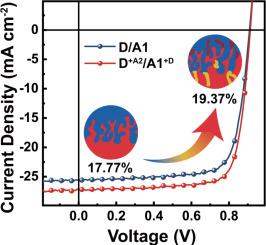Superior charge dynamics via ternary doping layer-by-layer strategy in high-efficiency organic solar cells
IF 13.2
1区 工程技术
Q1 ENGINEERING, CHEMICAL
引用次数: 0
Abstract
Nowadays, the preparation of pseudo-planar heterojunctions (P-PHJ) using the layer-by-layer (LbL) method has aroused considerable interest due to its merits in increasing the dimensions of pure domains and establishing vertical phase distribution, which is favorable for charge transport. However, the excessive pure domain scale can easily be generated in P-PHJ, thereby lowering the exciton dissociation efficiency. In this study, a ternary doping layer-by-layer (D-LbL) strategy is proposed to prepare the active layer of D + A2/A1 + D structure, where D18 is donor (D), L8-BO is acceptor 1 (A1), and BTP-eC9 is acceptor 2 (A2). A series of characterizations shows that the interpenetrating network structure and molecular crystallinity of the active layer are significantly optimized via the ternary D-LbL strategies, which ensures both exciton dissociation efficiency and charge transport efficiency. The organic solar cells (OSCs) based on D + A2/A1 + D exhibits an excellent photoelectric conversion efficiency of 19.37 % along with a high open-circuit voltage of 0.913 V, a superior short-circuit current density of 26.99 mA cm-2 and an excellent fill factor of 78.62 %, which is much superior to that of the binary P-PHJ OSCs (17.77 %). This work demonstrates that the ternary D-LbL strategy is an excellent approach for optimizing the active layer morphology to achieve outstanding charge dynamics.

在高效有机太阳能电池中采用三元掺杂分层策略的优越电荷动力学
目前,利用逐层(LbL)方法制备伪平面异质结(P-PHJ)由于其增加纯畴尺寸和建立有利于电荷输运的垂直相分布的优点而引起了人们的广泛关注。但在P-PHJ中容易产生过多的纯畴尺度,从而降低激子解离效率。本研究提出了一种三元掺杂分层(D- lbl)策略来制备D + A2/A1 + D结构的活性层,其中D18为供体(D), L8-BO为受体1 (A1), BTP-eC9为受体2 (A2)。一系列表征表明,三元D-LbL策略显著优化了活性层的互穿网络结构和分子结晶度,保证了激子解离效率和电荷输运效率。有机太阳能电池(osc)基于D + A2 / A1 + D展示一个优秀的光电转换效率为19.37 %随着高开路电压的0.913 V,优越的短路电流密度为26.99马 cm-2和一个很好的填充因数78.62 %,这远远优于二进制P-PHJ osc(17.77 %)。这项工作表明,三元D-LbL策略是优化活性层形态以实现出色电荷动力学的绝佳方法。
本文章由计算机程序翻译,如有差异,请以英文原文为准。
求助全文
约1分钟内获得全文
求助全文
来源期刊

Chemical Engineering Journal
工程技术-工程:化工
CiteScore
21.70
自引率
9.30%
发文量
6781
审稿时长
2.4 months
期刊介绍:
The Chemical Engineering Journal is an international research journal that invites contributions of original and novel fundamental research. It aims to provide an international platform for presenting original fundamental research, interpretative reviews, and discussions on new developments in chemical engineering. The journal welcomes papers that describe novel theory and its practical application, as well as those that demonstrate the transfer of techniques from other disciplines. It also welcomes reports on carefully conducted experimental work that is soundly interpreted. The main focus of the journal is on original and rigorous research results that have broad significance. The Catalysis section within the Chemical Engineering Journal focuses specifically on Experimental and Theoretical studies in the fields of heterogeneous catalysis, molecular catalysis, and biocatalysis. These studies have industrial impact on various sectors such as chemicals, energy, materials, foods, healthcare, and environmental protection.
 求助内容:
求助内容: 应助结果提醒方式:
应助结果提醒方式:


